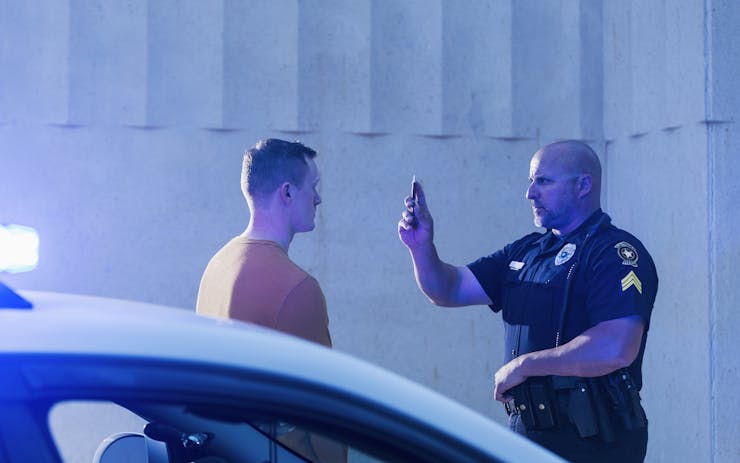Impaired driving has been around as long as people have been motoring. The first arrest for drunk driving was in 1897, long before any lab testing could be done. For decades, the issue of impairment while driving was ignored or under-appreciated. Drunk driving was commonplace and there were no regulations to prevent such actions. After countless deaths (including Gone with the Wind author Margaret Mitchell), efforts were made to quantify how drunk one could be while still getting behind the wheel of a car.
Per se laws represented a revolution in case law: The presence of alcohol in the blood above a certain level was sufficient to establish criminal impairment by proxy.
Where to draw the line? Different nations have adopted different standards. In establishing a blood limit for alcohol, the US initially selected a level of 0.15 (0.15 g of alcohol per 100 mL) then decreased it to 0.10, still higher than virtually all other developed nations, due to a combination of factors including spread out geography, alcohol industry lobbying and American libertarianism. Canada did not see per se laws introduced until 1969, when it became criminal to drive with a BAC of 0.08 or greater. Individual provinces have introduced additional penalties for drivers who are above a 0.05 limit.
Per se laws represented a revolution in case law, because no longer was it necessary to prove that the driver was unfit to drive at the accident or that the driver was impaired due to the alcohol rather than fatigue or medical infirmity. The presence of alcohol in the blood above that level was sufficient to establish criminal impairment by proxy. This has remained controversial, but the science is strong enough for the courts to have accepted this legislation.
Cannabis and Per Se Laws
As legalization of recreational cannabis looms over Canada, there have been public concerns about cannabis and driving, and how to regulate impairment from cannabis in the same way that we regulate impairment from alcohol. Both national and provincial governments in Canada have included per se limits within their legislation. Driving with a blood THC level greater than 5 ng/mL will be a federal crime, punishable by up to 10 years in prison. Driving with a blood THC level between 2 and 5 ng/mL is a summary offence with up to $1000 fine. Individual provinces have additional restrictions—Quebec is proposing a zero-tolerance policy.
Why do per se laws work for alcohol but not for cannabis? The primary reason is that alcohol and cannabis are different drugs.
However, there’s a problem with introduction of per se laws for cannabis—they aren’t based on good science.
As the US Department of Transportation put it in its 2017 National Highway Traffic Safety report, “A number of States have set a THC limit in their laws indicating that if a suspect’s THC concentration is above that level (typically 5 ng/ml of blood), then the suspect is to be considered impaired. This per se limit appears to have been based on something other than scientific evidence. Some recent studies demonstrate that such per se limits are not evidence-based.”
The American Automobile Association Foundation for Traffic Safety concurs: “Legal limits, also known as per se limits, for marijuana and driving are arbitrary and unsupported by science.”
Why do per se laws work for alcohol, but not for cannabis? The primary reason is that alcohol and cannabis are different drugs, with different effects and metabolism. Alcohol is water-soluble and diffuses rapidly throughout the body, with peak effects and impairment coming around one hour after ingestion and slowly dissipating in tandem with the blood-alcohol level over hours. At any point in this pathway, the blood-alcohol level can be measured and will reliably predict driving impairment.
Cannabis behaves very differently in the body, for a variety of reasons.
- THC is poorly soluble in blood, so it is taken up into the body’s fat stores rapidly. Maximum body THC levels occur around ten minutes after smoking, and one study showed that blood levels were down below 5 ug/L at 1.4 hours and below 2 at 3.3 hours (this was on average; some people remained above 2 for more than eight hours).
- Because THC can build up in fat cells and be subsequently released over a long time period, some people can still have THC in their blood from past exposure, with no discernible impairment. In the study quoted above, one participant had a positive THC level of 4.9-6.3 ug/L after overnight abstention on six different occasions. This person, along with many medical cannabis users, would be unable to ever drive legally, due to prolonged THC excretion, despite no evidence of impairment.
- By the time a blood level is drawn, there may be very little THC left in the blood. Impairment can last longer than three hours, yet most will be below the per se limit by that time. Due to individual variability and the rapid decline in THC levels, it is impossible to calculate the level of THC at the time of the accident based on a later blood level.
- A number of studies have found that it is not possible to link a random measurement of blood THC to impairment levels, as impairment can take place below 2 ng/mL. Equally, people with a level of THC in their blood of > 5 ng/mL can demonstrate no impairment. Wide variations in level of impairment are seen in different individuals with the same blood THC level.
How Did We End Up Here and Where Do We Go Now?
One reason for the continued use of per se laws, despite the absence of scientific validity, is simplicity. Breath-testing and per se laws are already in place for alcohol and an easy paradigm to imitate for other drugs. As described above, the problem is that alcohol is almost unique in having a close linkage between blood levels and impairment, while this has not been established for cannabis or other drugs.
One reason for the continued use of per se laws, despite the absence of scientific validity, is simplicity. Another reason is “security theatre.”
Another reason is “security theatre.” As already established in the airline industry, increased use of roadside devices plus use of per se laws enable government and law enforcement the appearance of doing something, even though cases made using these tools are unlikely to ever make it through a court. As we have seen in past cases of drug policy such as prescription heroin and safe injection sites, Canadian courts have tended to side with science over ideology. My expectation is that court challenges will begin as soon as the first charges are laid, and will likely be successful and require a reworking of the legislation.
As for now, given the lack of scientific validity for per se laws, how will law enforcement be able to identify and penalize drivers impaired by cannabis? While Drug Recognition Experts remain the standard, they are expensive to train and to maintain and they still face court challenges for objectivity. If we want to get serious about measuring impairment we will need to move to devices that gauge impairment by testing cognitive and physical functionality, along the lines of the DRUID app or Mercedes Attention Assist.





